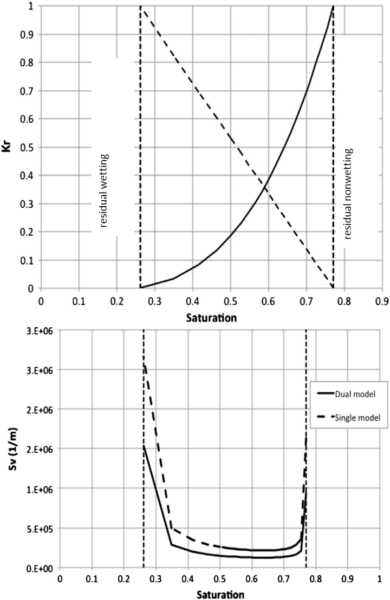
Top: Relative permeability curves for wetting (solid line) and nonwetting (dashed line) phases in the sand sample.
Bottom: Calculated specific surface area vs. normalized wetting-phase saturation calculated from the experimental data for the single and dual bundle capillaries models.
Scientific Achievement
Extended the theoretical approach and an analytical solution for the evaluation of a capillary pressure (Pc) curve in porous media based on the apparent specific surface area, using an explicit combination of the relative permeability functions for the wetting and nonwetting phases along with an equation for the apparent specific surface area and an apparent contact angle
Significance and Impact
It is shown that the relative permeability functions for the wetting and nonwetting phases can be used to implicitly take into account the geometry (topology), roughness and crevices of the heterogeneous porous medium, as well as obtain singularities at the residual points, which are difficult to obtain experimentally.
Research Details
The application of the capillary bundle models was applied to:
- Revise the results of calculations of the effective contact angles based on published Pc and relative permeability curves, and
- Validate the application of the capillary bundle models, using the results of the experimental study.
Citation
Babchin, A.J.; Bentsen, R.; Faybishenko, B.; Geilikman, M. B. (2016), On the capillary pressure function in porous media based on relative permeabilities of two immiscible fluids: Application of capillary bundle models and validation using experimental data, Advances in Colloid and Interface Science, 233, 176-185 DOI: 10.1016/j.cis.2015.07.001.
